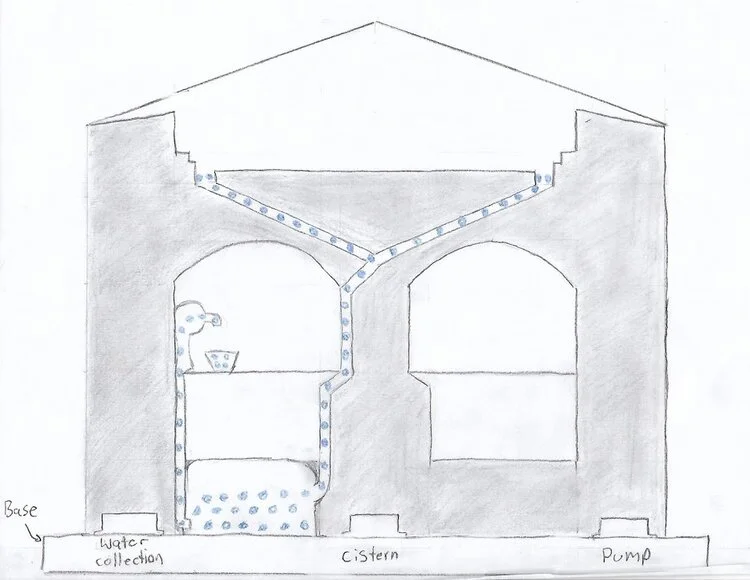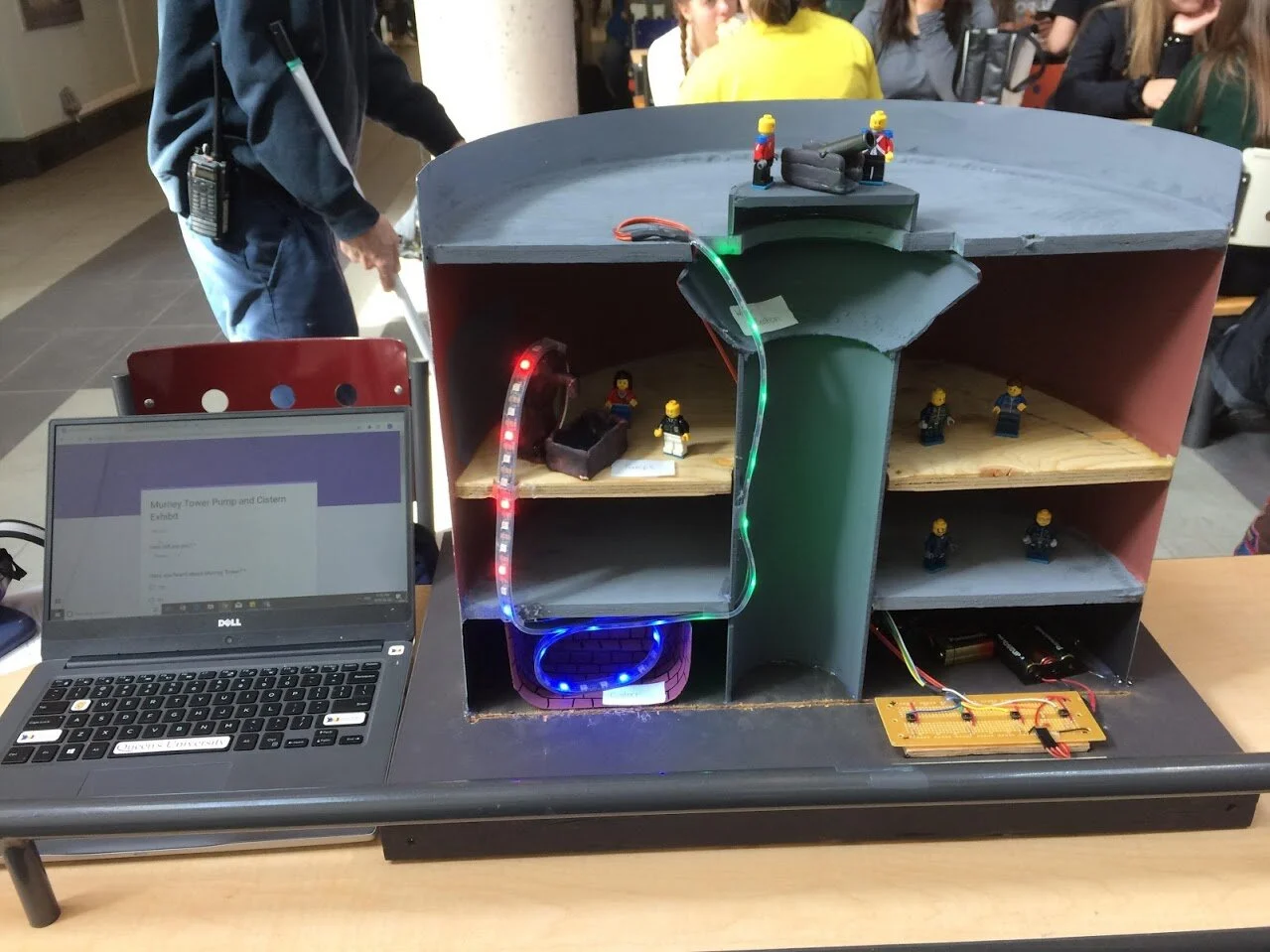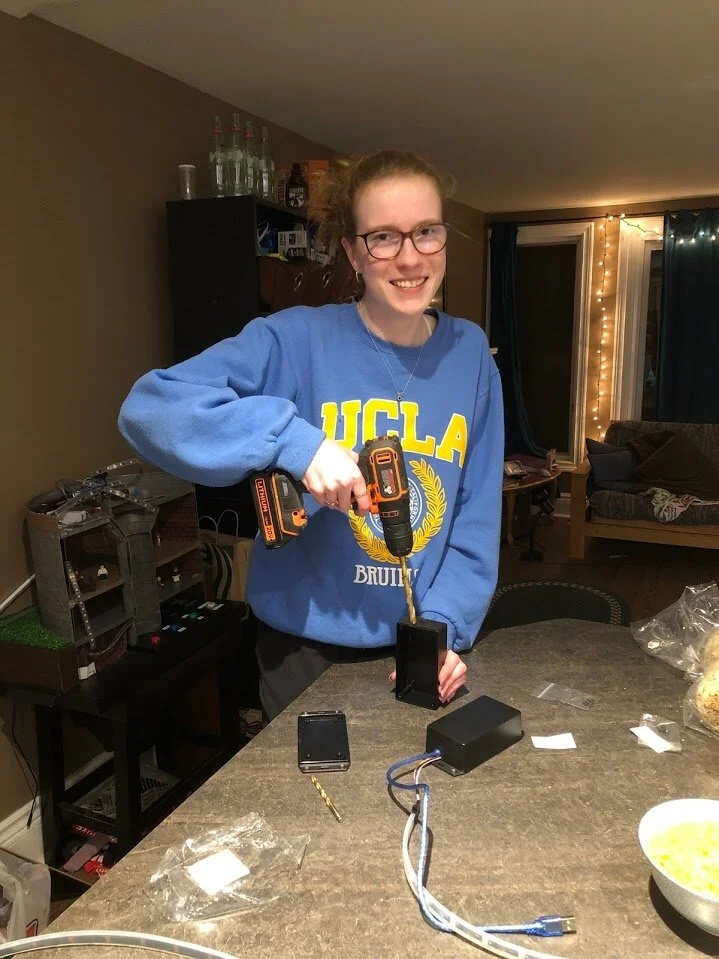Interactive Cistern Display
Over the past two years, the museum has worked with a team of Engineering undergraduate students from Queen’s University on the creation of a portable, interactive display to educate the public on how our cistern works. What began as a four-month school project turned into a long-term volunteer commitment from these enthusiastic students. The team enjoyed themselves so much they wanted to share their experience in writing, images, and video. You can check out a full video of their story here! The museum would like to thank Morgan, Naomi, Kate, and Julia!
Naomi Lamothe:
I started working on the Murney Tower project in my first year as part of an engineering design course. After the course finished, my team was approached by the museum and asked if we would be willing to continue with the project to make a more permanent display. I was originally in a group with Kate and Julia, but we were joined by Morgan after the first year. We have had the privilege of working on this project for the past two years now and it has been a wonderful experience. I really enjoyed working with my teammates and throughout the project, the museum was very supportive and helpful. It was amazing to be able to apply some of the things that I was learning about in school in a real-world engineering project for a client that will benefit the Kingston community. I chose this project in my first year because while I am an engineer and love to solve problems, I am also very interested in history and enjoy working with and teaching kids. Through this project, I had the opportunity to combine these three interests.
One of the highlights of the project for me was visiting a grade 5 class at École Catholique Cathédrale and giving them a presentation about Murney Tower and how we used the engineering design process to build our model, then having them test it and give us feedback. It was very rewarding to see their delight in the Lego people we used to show the people living in the tower and to listen to their feedback and answer all of their interesting questions.
The biggest challenge for me was learning the technical skills to build the circuits and write the code that would control them. I was the one responsible for most of the electronics, but, going into the project, I had very limited experience. I was able to overcome this challenge through using internet resources to teach myself and consulting with a lab technician. The circuit building, coding, and troubleshooting skills that I learned through this project have been valuable for me in my other courses.
Kate Theysmeyer:
Working with the Murney Tower Museum was a great experience. At the beginning of the project, we got to meet with the director of the museum and discuss what his vision for the new display was and what limitations there were in what we could design. We got to use a lot of creativity and problem-solving skills to come up with what we thought would be the best display, really putting into practice the engineering design process. We decided to represent the water flow with LED lights and buttons as it could withstand the conditions inside the tower, was mess-free, safe for kids to play with, and also engaging. A really fun part of this project was getting to go into a local school and do a presentation for one of the classes to assess how the kids liked the display and our presentation, as we understood outreach to local children was an important feature of the display. This project started out as a school project, but we all really enjoyed working on it, and getting the chance to further improve the product that we had worked on so hard during the school year was very rewarding. It is also great that we got to contribute to the local community of Kingston in an impactful way, while also getting to use the skills we are learning in school.
Julia Funk:
I really enjoyed turning the prototype built for our class project into a finished model that will be displayed in the historic Murney Tower Museum as well as used for outreach at schools. The process of learning about the pump and cistern system that was used in the 1846 military tower and then relaying it into an interactive model that would teach the public was an incredible experience. One of my favourite parts about the project was bringing the prototype to the École Catholique Cathédrale and letting the children learn about the history of the tower as well as the pump and cistern while interacting with our model. Seeing the look of awe and inspiration on the children’s faces was so fulfilling and made me so proud to have been part of this project. I am very excited to see the model on display in the museum and am so happy to share it with the public!
Morgan Trewin:
Working with the Murney Tower Museum was a wonderful privilege. I started the project in my first year of university and being able to work directly with a client was my first taste of real-world engineering! When I was offered to continue working with the museum after the course that this project was for ended, I joined a new group to continue working on the project. This was a challenge yet beneficial, as my previous group had made a museum prototype which was very different from my new group’s prototype. For example, my previous group’s prototype used actual water, while Julia, Naomi, and Kate’s prototype utilized lights and electronics. These differences allowed me to bring a new perspective to their design and helped us to tweak and refine their prototype to bring together the best of everyone’s ideas. This project was a wonderful experience because I got to go through the entire engineering process of idea generation, building, testing, and iteration. Seeing this project through to completion has interested me in project management, which I now hope to pursue post-graduation. I can’t wait for our prototype to be on display in the museum!




